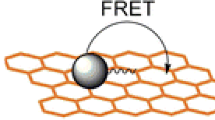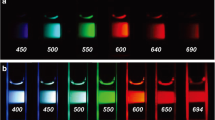Abstract
Carbon dots (CDs) modified with ethylene diamine (EDA) and the amino acids (AAs) Cys, His, Lys or Arg were synthesized, and their structures were confirmed by high resolution transmission electron microscopy, Raman spectrometry and X-ray photoelectron spectrometry. It is found that derivatization of the CDs with various AAs systemically modulates their electronic properties, and this results in a tunable selectivity in detection of metal cations via fluorescence quenching. The probes can be performed in aqueous solutions around pH 7. CDs can be excited under 345 nm excitation at room temperature and exhibit fluorescent peak at 450 nm. The decreasing fluorescence intensity is directly proportional to the concentration of metal cations. The limits of detection is 8.8 μg L−1 for Pb(II), 20 μg L−1 for Hg(II), 3.7 μg L−1 for Cu(II), 5.3 μg L−1 for Zn(II), 16 μg L−1 for Fe(III), and 7.2 μg L−1 for Cr(III), respectively. The different fluorescence response of the AA-modified CDs can be converted to logic gates and applied to photoelectronic nanoprobes by using microprocessors. In our perception, this assay has a large potential in terms of high-throughput screening for trace amounts of metal ions.

Amino acid derivatized carbon dots with tunable selectivity were synthesized by a one pot method for fluorescent sensing of metal cations. The sensing events can be directly converted into different logic gates.








Similar content being viewed by others
References
Zhou J, Zhou H, Tang J, Deng S, Yan F, Li W, Qu M (2017) Carbon dots doped with heteroatoms for fluorescent bioimaging: a review. Microchim Acta 184:343–368. doi:10.1007/s00604-016-2043-9
Zuo P, Lu X, Sun Z, Guo Y, He H (2016) A review on syntheses, properties, characterization and bioanalytical applications of fluorescent carbon dots. Microchim Acta 183:519–542. doi:10.1007/s00604-015-1705-3
Lim D, Byun WG, Koo JY, Park H, Park SB (2016) Discovery of a Small-Molecule Inhibitor of Protein − MicroRNA Interaction Using Binding Assay with a Site-Specifically Labeled Lin28. J Am Chem Soc 138:13630–13638. doi:10.1021/jacs.6b06965
Lin S, Gao W, Tian Z, Yang C, Lu L, Mergny J-L, Leung C-H, Ma D-L (2015) Luminescence switch-on detection of protein tyrosine kinase-7 using a G-quadruplex-selective probe. Chem Sci 6:4284–4290. doi:10.1039/c5sc01320h
Wang M, Mao Z, Kang T-S, Wong C-Y, Mergny J-L, Leung C-H, Ma D-L (2016) Conjugating a groove-binding motif to an Ir(III) complex for the enhancement of G-quadruplex probe behaviour. Chem Sci 7:2516–2523. doi:10.1039/c6sc00001k
Yang C, Wang W, Chen L, Liang J, Lin S, Lee M-Y, Ma D-L, Leung C-H (2016) Discovery of a VHL and HIF1a interaction inhibitor with in vivo angiogenic activity via structurebased virtual screening. Chem. Commun. 52:12837–12840. doi:10.1039/c6cc04938a
Zhang C-Y, Yeh H-C, Kuroki MT, Wang T-H (2005) Single-quantum-dot-based DNA nanosensor. Nat Mater 4:826–831. doi:10.1038/nmat1508
Jin T, Sasaki A, Kinjo M, Miyazaki J (2010) A quantum dot-based ratiometric pH sensor. Chem Commun 46:2408–2410. doi:10.1039/C2CC33796G
Wang D, Lin Z, Mccleese C, Burda C, Chen J-F, Dai L (2016) Fluorescent carbon dots from milk by microwave cooking. RSC Adv. 6:41516–41521. doi:10.1039/C6RA06120F
Sahu S, Behera B, Maiti TK, Mohapatra S (2012) Simple one-step synthesis of highly luminescent carbon dots from orange juice: application as excellent bio-imaging agents. Chem Commun 48:8835–8837. doi:10.1039/C2CC33796G
Liu S, Zhao N, Cheng Z, Liu H (2015) Amino-functionalized green fluorescent carbon dots as surface energy transfer biosensors for hyaluronidase. Nanoscale 7:6836–6842. doi:10.1039/C5NR00070J
Ding C, Zhu A, Yang T (2014) Functional surface engineering of C-Dots for fluorescent biosensing and in Vivo bioimaging. Acc Chem Res 47:20–30. doi:10.1021/ar400023s
Wang J, Ng Y-H, Lim Y-F, Ho G-W (2014) CD photocatalysis Vegetable-extracted carbon dots and their nanocomposites for enhanced photocatalytic H2 production. RSC Adv 2014(4):44117–44123. doi:10.1039/c4ra07290a
Cheng Z, Wang F, Shifa TA, Liu K, Huang Y, Liu Q, Jiang C, He J (2016) Carbon dots decorated vertical SnS2 nanosheets for efficient photocatalytic oxygen evolution. Appl Phys Lett 109:053905. doi:10.1063/1.4960527
Zheng H, Wang Q, Long Y, Zhang H, Huang X, Zhu R (2011) Enhancing the luminescence of carbon dots with a reduction pathway. Chem Commun 47:10650–10652. doi:10.1039/C1CC14741B
Zhao Q-L, Zhang Z-L, Huang B-H, Peng J, Zhang M, Pang D-W (2008) Facile preparation of low cytotoxicity fluorescent carbon nanocrystals by electrooxidation of graphite. Chem Commun 44:5116–5118. doi:10.1039/B812420E
Hsu P-C, Shih Z-Y, Lee C-H, Chang H-T (2012) Synthesis and analytical applications of photoluminescent carbon nanodots. Green Chem 14:917–920. doi:10.1039/C2GC16451E
Li H, Kang Z, Yang L, Lee S-T (2012) Carbon nanodots: synthesis, properties and applications. J Mater Chem 22:24230–24253. doi:10.1039/C2JM34690G
Zhu S, Meng Q, Wang L, Zhang J, Song Y, Jin H, Zhang K, Sun H, Wang H, Yang B (2013) Highly photoluminescent carbon dots for multicolor patterning, pensors, and bioimaging. Angew Chem Int Ed 52:953–3957. doi:10.1002/anie.201300519
Zhai X, Zhang P, Liu C, Bai T, Li W, Daic L, Liu W (2012) Highly luminescent carbon nanodots by microwave-assisted pyrolysis. Chem Commun 48:7955–7957. doi:10.1039/C2CC33869F
Wang Z, Xu C, Lu Y, Chen X, Yuan H, Wei G, Ye G, Chen J (2017) Fluorescence sensor array based on amino acid derived carbon dots for pattern-based detection of toxic metal ions. Sens actuators B Chem. 241:1324–1330. doi:10.1016/j.snb.2016.09.186
Li S, Li Y, Cao J, Zhu J, Fan L, Li X (2014) Sulfur-Doped Graphene Quantum Dots as a Novel Fluorescent Probe for Highly Selective and Sensitive Detection of Fe3+. Anal Chem 86:10201–10207. doi:10.1021/ac503183y
Jian J, Chen W (2014) Synthesis of highly fluorescent nitrogen-doped graphene quantum dots for sensitive, label-free detection of Fe (III) in aqueous media. Biosens Bioelectron 58:219–225. doi:10.1016/j.bios.2014.02.061
Hu Y, Yang J, Tian J, Jia L, Yu J-S (2014) Waste frying oil as a precursor for one-step synthesis of sulfur-doped carbon dots with pH-sensitive photoluminescence. Carbon 77:775–782. doi:10.1016/j.carbon.2014.05.081
Ossowicz P, Janus E, Schroeder G, Rozwadowski Z (2013) Spectroscopic Studies of Amino Acid Ionic Liquid-Supported Schiff Bases. Molecules 18:4986–5004. doi:10.3390/molecules18054986
Lemire JA, Harrison JJ, Turner RJ (2013) Antimicrobial activity of metals: mechanisms, molecular targets and applications. Nat Rev Microbiol 11:371–384
Satapathy R, Wu Y-H, Lin H-C (2012) Novel Thieno-imidazole Based Probe for Colorimetric Detection of Hg2+ and Fluorescence Turn-on Response of Zn2+. Org Lett 14:2564–2567
Kim KY, Jung SH, Lee J-H, Lee SS, Jung JH (2014) An imidazole-appended p-phenylene-Cu(II) ensemble as a chemoprobe for histidine in biological samples. Chem Commun 50:15243–15246
Wee SS, Ng YH, Ng SM (2013) Synthesis of fluorescent carbon dots via simple acid hydrolysis of bovine serum albumin and its potential as sensitive sensing probe for lead (II) ions. Talanta 116:71–76
Mu L, Shi W, She G, Chang JC, Lee S-T (2009) Fluorescent logic gates chemically attached to silicon nanowires. Angew Chem Int Ed 48:3469–3472. doi:10.1002/anie.200805015
Author information
Authors and Affiliations
Corresponding authors
Ethics declarations
The author(s) declare that they have no competing interests.
Electronic supplementary material
ESM 1
(DOC 11499 kb)
Rights and permissions
About this article
Cite this article
Cheng, HJ., Kao, CL., Chen, YF. et al. Amino acid derivatized carbon dots with tunable selectivity as logic gates for fluorescent sensing of metal cations. Microchim Acta 184, 3179–3187 (2017). https://doi.org/10.1007/s00604-017-2336-7
Received:
Accepted:
Published:
Issue Date:
DOI: https://doi.org/10.1007/s00604-017-2336-7




